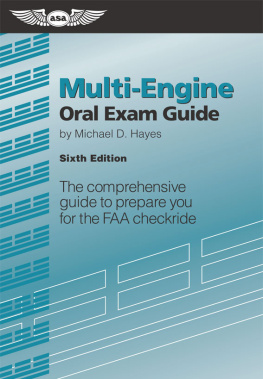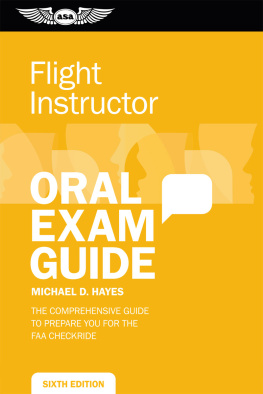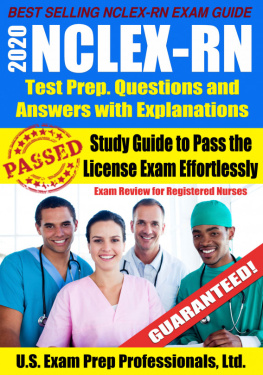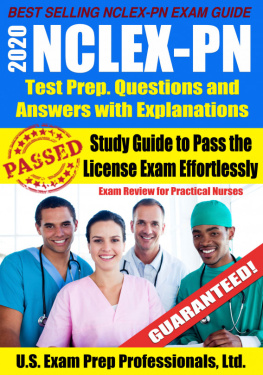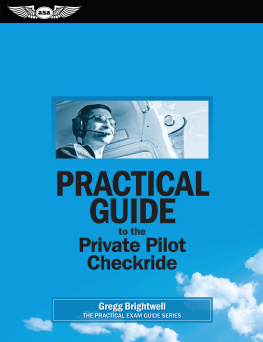Multi-Engine Oral Exam Guide
Sixth Edition
by Michael D. Hayes
Aviation Supplies & Academics, Inc.
7005 132nd Place SE
Newcastle, Washington 98059-3153
Visit ASAs website often (www.asa2fly.com) to find updates posted there due to FAA regulation revisions that may affect this book.
19942012 Aviation Supplies & Academics, Inc.
All rights reserved. Sixth Edition published 2012.
No part of this book shall be reproduced, stored in any retrieval system, or transmitted by any means, electronic, mechanical, xerographic, audio/visual record, or otherwise, without written permission from the publisher. While every precaution has been taken in the preparation of this book, the publisher and Michael D. Hayes assume no responsibility for errors or omissions. Neither is any liability assumed for damages resulting from the use of the information contained herein. None of the material in this guide supersedes any documents, procedures, or regulations issued by the Federal Aviation Administration.
ASA-OEG-ME6-EB
ePub ISBN 978-1-56027-967-9
Kindle ISBN 978-1-56027-968-6
LC# 94-5808
This guide is dedicated to the many talented students, pilots, and flight instructors I have had the opportunity to work with over the years. Also, special thanks to Mark Hayes and many others who supplied the patience, encouragement, and understanding necessary to complete the project.
M.D.H.
Introduction
The Multi-Engine Oral Exam Guide is a comprehensive guide designed for pilots training for the addition of a Multi-Engine Land rating to an existing Private Pilot Certificate. This guide was originally designed for use in Part 141 flight schools, but it quickly became popular with those training under Part 61 who are not affiliated with an approved school. The guide also proves beneficial to pilots who wish to refresh their knowledge or who are preparing for a flight review.
The Multi-Engine Oral Exam Guide is divided into four main sections. The first three sections represent the basic subject areas in which knowledge must be demonstrated by the applicant before they are issued the Multi-Engine rating. The fourth section is a general review of the procedures and maneuvers required during the flight portion of the checkride. You should review the Practical Test Standards applicable to your particular certification check (i.e., Commercial, Instrument), in addition to the material in this section. For your convenience, Appendix 1 has been included which contains the Applicants Practical Test Checklist. Additionally, for an in-depth review of your aircraft, Appendix 2 contains all of the most commonly asked questions about aircraft performance, limitations, systems, and procedures.
An FAA examiner may ask questions at any time during the practical test to determine the applicant has the required knowledge. The result of intensive post-multi checkride debriefings, this book provides the most consistent questions asked, along with the information necessary for a knowledgeable response.
The guide may be supplemented with other comprehensive study materials as noted in parentheses after each question. For example: (FAA-H-8083-1). The abbreviations for these materials and their titles are listed below. Be sure to use the latest revision of these references when reviewing for the test.
14 CFR Part 23Airworthiness Standards: Normal, Utility, Acrobatic, and Commuter Category Airplanes
14 CFR Part 43Maintenance, Preventive Maintenance, Rebuilding, and Alteration
14 CFR Part 61Certification: Pilots, Flight Instructors, and Ground Instructors
14 CFR Part 91General Operating and Flight Rules
AC 61-67Stall and Spin Awareness Training
AC 91-67Minimum Equipment requirements for General Aviation Operations under 14 CFR Part 91
AC 91-73Part 91 and 135 Single-Pilot Procedures During Taxi Operations
AC 150-5340-18Standards for Airport Sign Systems
FAA-H-8083-1Aircraft Weight and Balance Handbook
FAA-H-8083-3Airplane Flying Handbook
FAA-H-8083-25Pilots Handbook of Aeronautical Knowledge
FAA-H-8083-31Aviation Maintenance Technician HandbookAirframe
FAA-H-8083-32Aviation Maintenance Technician HandbookPowerplant
FAA-P-8740-19Flying Light Twins Safely
FAA-S-8081-14Private Pilot Airplane Multi-Engine Land Practical Test Standards
FAA Safety ALC-30FAA Multi-Engine Safety Review
AFMFAA-Approved Flight Manuals
AIMAeronautical Information Manual
POHPertinent Pilot Operating Handbooks
SAIB CE-10-11FAA Special Airworthiness Information Bulletin CE-10-11, Electrical: Fire Hazard in Resetting Circuit Breakers (C/Bs)
Most of the books listed above are reprinted by ASA and available from aviation retailers worldwide. A review of the information presented within this guide should provide the necessary preparation for the FAA Multi-Engine Land practical test.
Were you asked a question during your checkride that was not covered in this book? If so, please send the question to ASA. We are constantly striving to improve our publications to meet the industry needs. Visit the ASA website for updates that may be posted in between printings, on the Product Update webpage.
Aviation Supplies & Academics
7005 132nd Place SE
Newcastle, WA 98059-3153
internet:www.asa2fly.com
email:asa@asa2fly.com
Fax:425.235.0128
Multi-Engine Operations
A.Normal Procedures
1.What documents are required on board a multi-engine aircraft? (14 CFR 91.9, 91.203)
Airworthiness Certificate
Registration Certificate
Owners manual or operating limitations
Weight and balance data
2.What are the required tests and inspections to be performed on multi-engine aircraft? (Include inspections for IFR.) (14 CFR 91.409, 91.171, 91.411, 91.413, 91.207)
A Annual inspection and applicable airworthiness directives complied with every 12 calendar months. (14 CFR 91.409)
V VOR check, if used for IFR, every 30 days. (14 CFR 91.171)
1 100-hour inspection, if used for hire or flight instruction. (14 CFR 91.409)
A Altimeter, altitude reporting equipment, and static pressure systems tested and inspected (for IFR operations), every 24 calendar months. (14 CFR 91.411)
T Transponder tests and inspections, every 24 calendar months. (14 CFR 91.413)
E Emergency locator transmitteroperation and battery condition inspected every 12 calendar months. (14 CFR 91.207)
3.Is taxiing a multi-engine airplane significantly different than taxiing a single-engine airplane? (FAA-H-8083-3)
No, it is generally the same. The following general guidelines may be used:
a.Brakes and throttles are used to control momentum.
b.Steering is done primarily with the steerable nose wheel.
c.Directional control may also be obtained through use of differential power, if necessary.
d.Plan ahead. Multi-engine airplanes are heavier, larger, and more powerful. They require more time and distance to stop.
e.Also, due to size, pilot perspective may change, requiring additional vigilance to avoid obstacles, other aircraft, or bystanders.
4.How can a pilot use differential power during taxiing? (FAA-H-8083-3)
While taxiing, a tight turn to the right, for example, may be accomplished by reducing power on the right engine and increasing power on the left engine while applying right rudder/brake. Also, in a crosswind condition, differential power assists in controlling direction. Power should be applied on the upwind engine causing a turning moment away from the crosswind.

